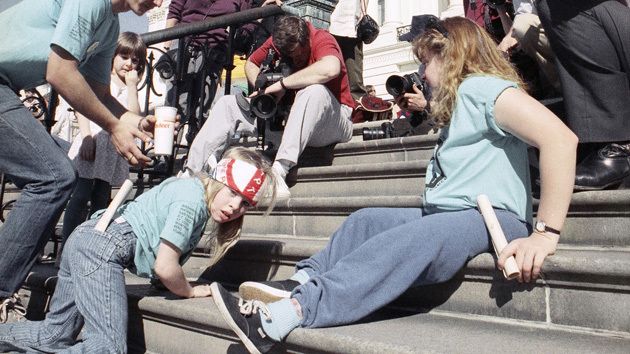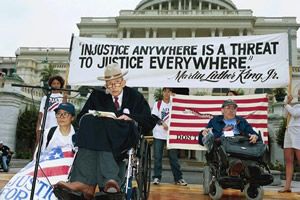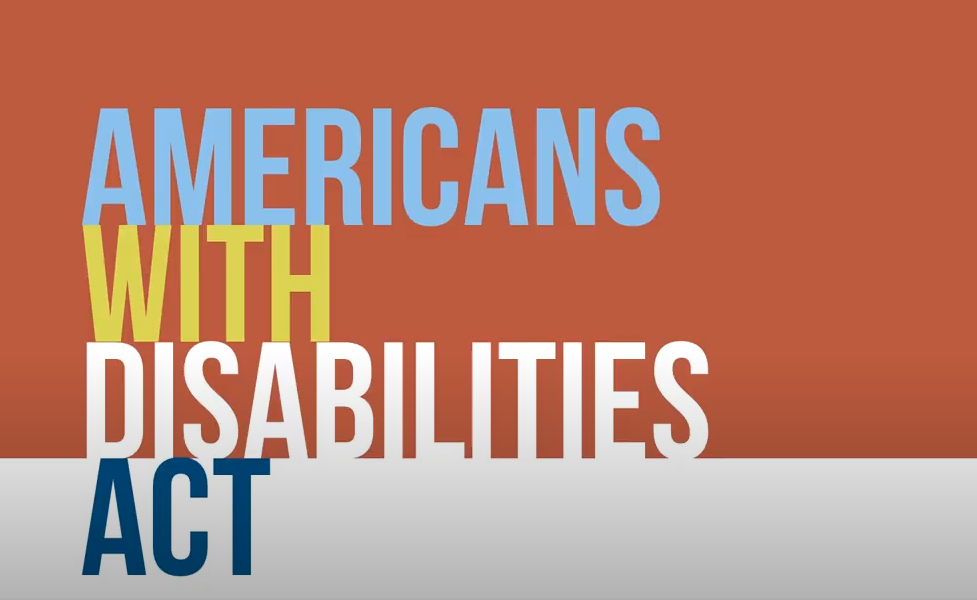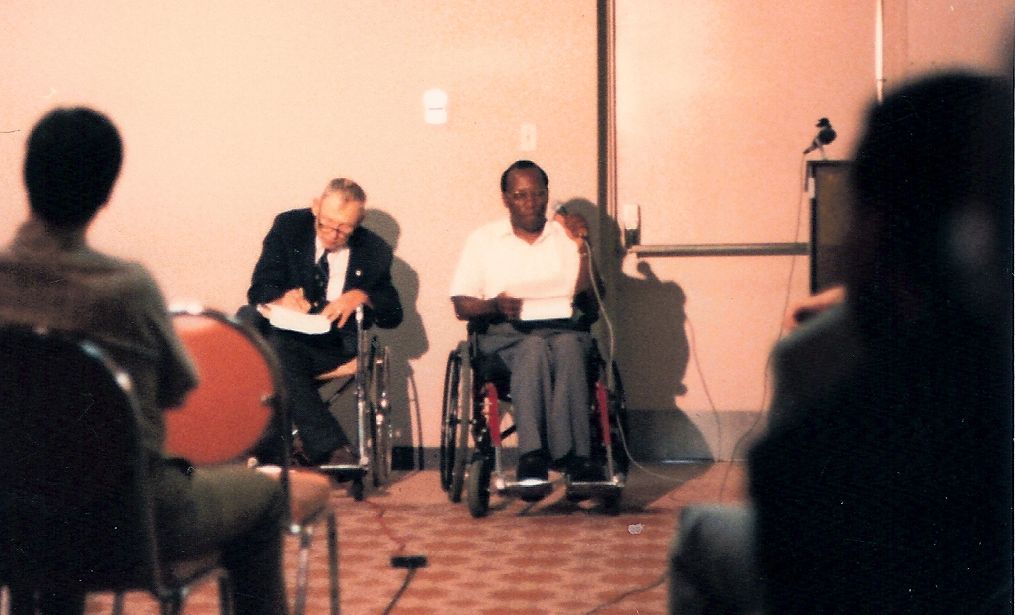
The Whole Person Celebrates the 34th Anniversary of the ADA
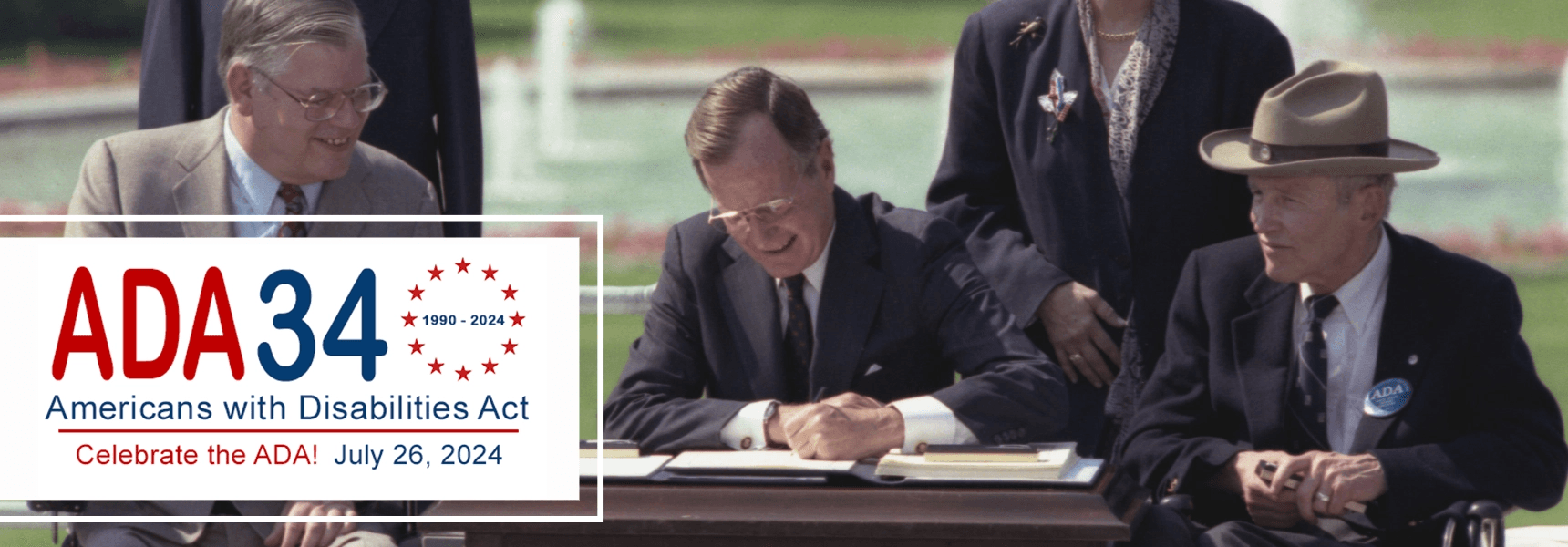
You are invited!
Join us as we celebrate the 34th Anniversary of the ADA!
Friday, July 26, 11:30 am-1:30 pm
3710 Main Street, Kansas City, MO
Food - Drinks - Voter Registration - Games - Prizes
All are welcome! Free event!
At the signing of the Americans with Disabilities Act (ADA) on July 26, 1990, President George H.W. Bush stated: “The Americans with Disabilities Act presents us all with an historic opportunity. It signals the end to the unjustified segregation and exclusion of persons with disabilities from the mainstream of American life. As the Declaration of Independence has been a beacon for people all over the world seeking freedom, it is my hope that the Americans with Disabilities Act will likewise come to be a model for the choices and opportunities of future generations around the world." (Click here for transcript of statement by The President July 26, 1990)
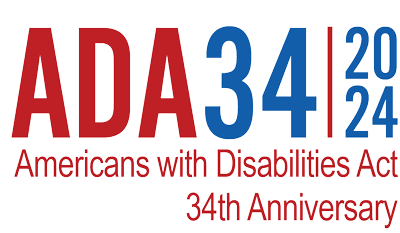
The Americans with Disabilities Act celebrates its 34th anniversary on July 26, 2024. The ADA’s profound influence on the way people with disabilities experience all aspects of daily life calls for celebration. In 1990 the Americans with Disabilities Act was signed into law, a triumphal moment for American civil rights.
The ADA is a civil rights law that prohibits discrimination against individuals with disabilities in all areas of public life. Its purpose is to make sure people with disabilities have the same rights and opportunities as everyone else. The law address jobs, schools, transportation, and all public and private places that are open to the general public.
Five sections of the ADA relating to public life include:
- Title I – Employment
- Title II – Public Services: State and Local Government
- Title III – Public Accommodations and Services Operated by Private Entities
- Title IV – Telecommunications
- Title V – Miscellaneous Provisions
How the ADA Changed the Built World | Crip Camp | Netflix Film Club
Here’s a look at how the ADA changed our physical landscape, featuring disability rights activists from the film "Crip Camp."
History of the ADA
Capitol Crawl
This video covers part of the Wheels of Justice rally and then the Capitol Crawl that took place on the west (Mall) side steps of the US Capitol March 12, 1990. This action, in which hundreds of people with disabilities took part, was done to push the Congress to move forward on the landmark civil rights bill, the Americans with Disabilities Act, ADA. The ADA had stalled in Congress and the disability community rose up to say enough is enough. It was part of a several day action by ADAPT to move Congress to act. It was also the culmination of a massive national grassroots effort by organizations and individuals from every state and territory in the nation to call for an end to discrimination based on disability. It symbolized the struggle people with disabilities faced in dealing with the society's discrimination, and the strength and perseverance of people with disabilities in facing these obstacles.
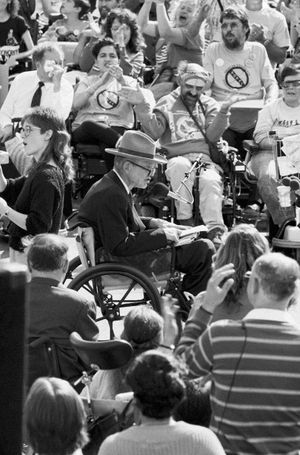
Justin Dart addresses the crowd of activists at the West Front of the Capitol preceding the Capitol Crawl in March 1990. (photo by Tom Olin)
The Disability Rights Movement
Treatment and perceptions of disability have undergone transformation since the 1900s. This has happened largely because people with disabilities have demanded and created those changes. Like other civil rights movements, the disability rights movement has a long history. Examples of activism can be found among various disability groups dating back to the 1800s. Many events, laws, and people have shaped this development. To date, the 1990 Americans with Disabilities Act (ADA) and the subsequent ADA Amendments Act (2008) are the movement’s greatest legal achievements. The ADA is a major civil rights law that prohibits discrimination of people with disabilities in many aspects of public life. The disability rights movement continues to work hard for equal rights. (read full article here)
Self-advocacy groups have also shaped the national conversation around disability. Self-advocacy means representing one's own interests. Such groups include DREDF (Disability Rights Education and Defense Fund), ADAPT (Americans Disabled Attendant Programs Today), and the NCIL (National Council on Independent Living). The National Council on Independent Living is the longest-running national cross-disability, grassroots organization run by and for people with disabilities. Founded in 1982, NCIL represents thousands of organizations and individuals including: individuals with disabilities, Centers for Independent Living (CILs), Statewide Independent Living Councils (SILCs), and other organizations that advocate for the human and civil rights of people with disabilities throughout the United States.
ADA History Videos
(click title to view in a separate window)
Disability Pioneers and Activists
Ed Roberts - Father of the Independent Living Movement
Zona Roberts, Ed Robert’s mother, later went to work for the PDSP and travelled widely with Ed, advocating for disability rights around the world. She emphasized that young activists like her son modeled for other disabled people and their families that opportunity for education and independence could be possible. Youth movements have always been a part of the quest for disability rights. (Google Impact Challenge: Disabilities 2015)
Judy Heumann - Disability Rights Activist
In 1970, New York Department of Education denied Judy Heumann a teaching license because she couldn’t walk, due to post-polio paralysis. She sued and made the story go “viral” in the newspapers of the day, forcing the department to change their policy. As other people with disabilities reached out to her, they founded a new cross-disability political activist organization, Disabled in Action. A few years later, she moved out to Berkeley to become Deputy Director of the Center for Independent Living, just as a new issue was emerging: Section 504. (Google Impact Challenge: Disabilities 2015) Link to TED Talk.
The ADA Diaries were a collection of stories about disability discrimination from all over the country assembled by Justin and Yoshiko Dart. The Darts traveled all over the country for years hosting gatherings where people with disabilities would tell their stories of discrimination, segregation and inequality. The Congressional Task Force on the Rights and Empowerment of People with Disabilities, chaired by Justin Dart Jr., invited some of the participants in the ADA diaries to testify directly to Congress. These individuals helped make the discrimination experienced by people with disabilities more real to Congress and the national me, arguing they weren’t looking for special rights, but just fairness and access to the rest of society. (Google Impact Challenge: Disabilities 2015)
Tom Harkins - Former Senator who introduced the ADA to the Senate
When the ADA passed the Senate, Tom Harkin delivered the first speech on the Senate floor in sign language, sending a message of solidarity to his brother Frank, and millions of other disabled Americans who needed the help promised by this bill. (Google Impact Challenge: Disabilities 2015)
LINK to speech in ASL on July 13, 1990

Disability Pride
July is Disability Pride Month, a time to recognize the strength, resilience, and achievements of people with disabilities. Let's celebrate the countless contributions made by individuals with disabilities to our communities, workplaces, and society. Their unique perspectives and talents enrich our world and inspire us to create a more inclusive and accessible future for everyone.
In July, and every month, let's raise awareness, challenge stereotypes, and promote inclusivity. Together, we can foster a society that recognizes and values the abilities and potential of every individual, regardless of their disabilities. Join us in spreading the message of acceptance, empowerment, and respect for people with disabilities. Together, we can create a world where everyone is celebrated for who they are and what they bring to the table.
The Disability Pride Flag: Five diagonal stripes of different colors rest on a black background. The black field mourns the victims of violence and abuse against persons with disabilities. The diagonal suggests cutting across barriers that separate the disabled from society. The flag’s five colors represent different types of disabilities: red (physical disabilities), gold (neurodivergence), white (invisible and undiagnosed disabilities), blue (psychiatric disabilities) and green (sensory disabilities)
Be a Disability Ally
Learn more by visiting the links below.
Resources / Links for extended information
-
Interactive timeline from the ADA National Network
-
The ADA is divided into five titles (or sections) that relate to different areas of public life.
-
ADA34 Anniversary website with a large toolkit of resources, links, and social sharing ideas
-
This exhibit celebrates just some of the many groups and people who made the ADA possible. (Google Impact Challenges: Disabilities)
-
A Movement Perspective by DREDF - Disability Rights Education & Defense Fund
The Whole Person Historical Photos
(click image to enlarge)

